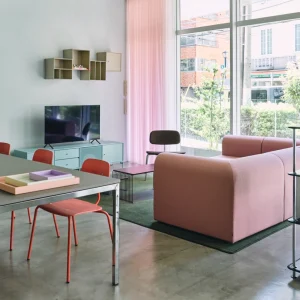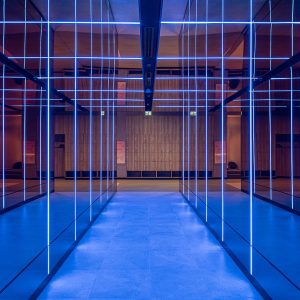Over the past decade advances in green building and the standards set for construction and refurbishments have resulted in a more environmentally conscious approach to design and construction. Occupants’ health and wellbeing have been less of a priority. In the past year, a new assessment method has emerged that marries the concern of health and wellbeing with the desire for environmental sustainability. The WELL Building Standard, the first standard of its kind that focuses attention solely on the health and wellness of building occupants, gives a building standard that allows for total human sustainability.
Through 102 performance metrics, design strategies and procedures, it comprehensively looks at all components of a building and analyses how these could affect an occupant’s health and comfort, in an attempt to be proactive instead of reactive. Sustainability is not just about the green agenda; it is about creating shared values and taking into account the ethical and social considerations of a workplace. It’s about being in balance and looking after all aspects of the organisation, not just ‘looking green’, but protecting and enhancing occupant health and improving productivity.
Changing times
In the past year, the World Green Building Council has encouraged companies to focus more on how design can improve workers’ health, wellbeing and productivity, and suggests incorporating metrics that address physical, perceptual and financial outcomes. The relationship between people and the building they work in is vital, but often overlooked. A recent British Council of Offices survey of UK office workers found that high percentages of respondents were dissatisfied with their office design and were specifically unhappy with their workspace if there was a lack of colour (80 per cent), a lack of greenery (64 per cent) and a lack of art (61 per cent).
The majority of businesses are missing a trick in ignoring the enormous opportunity this relationship presents. As an example, salaries and benefits typically account for 85 per cent of an organisation’s operating costs, far greater than energy and even office rent. The productivity of staff, or anything that affects their ability to be productive, should be a major concern for any employer, and so the building they operate in should be a key interest.
For facilities managers, the idea that buildings influence the health, wellbeing and productivity of their occupants is not new. But, this type of thinking is still not influencing most design, financing and leasing decisions.
Uniform conditions
In the past, design has focused on providing uniform conditions in an office – whether this is connected to the thermal, visual and acoustic characteristics of that office.
Examples might include defining ventilation rates per person, desk sizes per person and other BCO 2014 standards for fit-out. But, we need to start taking this idea one step further and look at the dynamic conditions related to the idea that transient experiences can have a positive effect on mindsets. Beauty, colour and biophilia are all examples of ways that the design of the built environment can contribute to positive multisensory experiences that can be both aesthetically pleasing and calming.
The traditional methods of design remain perfectly valid, and selecting sustainable materials, improved acoustics or energy efficient lighting are still important. These aspects continue to have a positive impact on a person’s wellbeing as well as addressing many important issues within the workspace. But, while these traditional considerations should not be dismissed, WELL provides a fresh focus on certain aspects, which have an even greater impact on wellbeing. There are seven such concepts which the WELL Building Standard focuses on, and should be considered by designers and facilities professionals within their building:
- Air – WELL establishes requirements for optimal indoor air quality to support the health and wellbeing of those occupying the building. This enables an informed decision for ventilation system design and strategy to be applied.
- Water – Safe and clean supply must be available for various uses through filtration and other purification techniques. The design of such systems should be based around meeting WELL requirements.
- Nourishment – The availability of fresh, wholesome foods must be available to encourage healthy eating habits and food culture. The provision of various catering spaces and the way in which they interact with the rest of the design should be reflected.
- Light – Illumination guidelines should be followed to minimise disruption to the body’s circadian system (daily cycle) in order to enhance productivity and alertness, and help promote effective sleep. Maximising natural light should be a key factor in a building’s design.
- Fitness – The seamless integration of exercise and fitness into everyday life through the integration of physical components supports an active and healthy lifestyle. Providing spaces for workers to spend time away from their desks and supporting movement are areas for consideration.
- Comfort – The design of the space should be distraction-free and promote a productive and comfortable environment. The ability to tailor a workspace to the individual is one element that provides comfort to the user.
- Mind – Thinking beyond the physical body and the way it interacts with the environment, the design should optimise cognitive and emotional wellbeing through contemplating the design, technology and treatment strategies.
Origins
Well is a creation of the American organisation Delos Living, whose objective is ‘to build a better world’. The idea is to implement best practice in design and construction based on empirical findings from medical and other scientific research to maximise human health and wellbeing using the built environment as the vehicle of delivery. The tool is based on a thorough review of the existing research on the effects of indoor spaces on individuals, and has been advanced through a comprehensive peer review. In order to achieve the requirements of the WELL Building Standard, the space must undergo a process that includes an onsite assessment and performance testing by a third-party.
There is some synergy between WELL and existing standards. WELL is third-party certified by the same body which certifies the LEED Green Building Rating System. There is also a ‘green’ thread woven through WELL, as aspects of wellbeing and health that are promoted are likely to have an environmentally beneficial element. The attention to occupants’ health and wellbeing is undergoing an emerging movement of advocacy. Great progress has been made from an environmental standpoint to the design and construction of built environments; now the same importance is becoming apparent for the benefits of those occupying such buildings.
CBRE: WELL Case Study
The global real estate company CBRE recently constructed its new headquarters in Los Angeles using ideas influenced by WELL. The company wanted a headquarters that improved their employees’ wellbeing, making them both healthier and happier. It is an office made-up of plenty of open-plan spaces, naturally illuminated through large windows and skylights. It boasts a range of meeting room options; quiet spaces to retreat and reflect, such as phone rooms and a wellness room. There is even a celebration space in a lounge, adjacent to a patio area.
Beyond the impressive design and layout of this office space, further consideration has gone into the services, furniture and aesthetics of the building to enhance the occupants’ experience. This includes more than 1,000 plants throughout the office to better connect the employees to nature, 100 per cent filtered air for vastly improved air quality, anti-microbial work surfaces, a water-treatment system designed to eradicate impurities, as well as ergonomically crafted furniture for greater comfort and flexibility.
Flooring’s Contribution
By Mark Bauer, environment specialist at Forbo Flooring Systems
People are increasingly interested in their own health and the consumer health market is expected to grow by 50 per cent in the next five years. There is now a focus on improving the physical office environment to improve the health and wellbeing of employees, in order to increase productivity and retention rates. Recognising this shift in office design, flooring manufacturers are starting to focus on designing and offering products that contribute to the health and comfort of individuals in a building.
This complements the UK Green Building Council’s (UKGBC) mission, as outlined in its Health, Wellbeing and Productivity in Offices report, to radically improve the sustainability of the built environment by transforming the way it is planned, designed, constructed, maintained and operated. The report found that buildings have a material impact on the health, wellbeing and productivity of occupants.
Although floors are only part of a healthy and productive environment, they provide an important role in design offering multiple benefits – adding to atmosphere, contributing to improved air quality, reducing the impact of sound and helping to create hygienic environments. Flooring also provides the capability to reflect light, provide comfort and texture as well as delineating spaces. With this in mind, search for manufacturers whose portfolios offer floor coverings that have low Volatile Organic Compounds (VOCs), are phthalate-free, deliver sound-reducing surface solutions, are Allergy UK approved and have high Light Reflectance Value (LRV) ratings – all have a positive impact on those occupying a building.
It is worth noting that as exposure to light regulates the circadian rhythm, which determines sleep and wake cycles, the WELL Building Standard states that to promote alertness and activity, the circadian cycle is most sensitive to lights of high frequency and intensity. Floor coverings with high LRV ratings allow additional light, from artificial or natural sources, to reflect off the floor and brighten the space efficiently; the more light a workspace experiences, the more users will benefit from an improved and healthier working environment.





